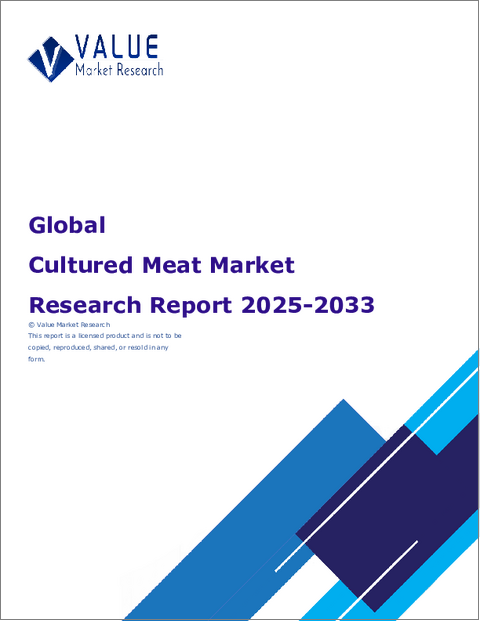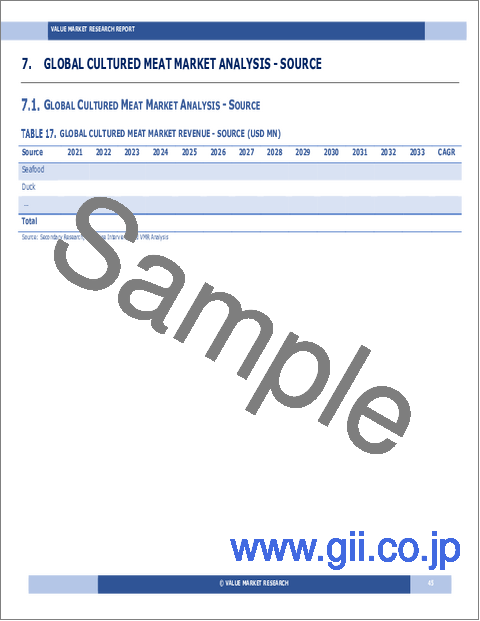|
|
市場調査レポート
商品コード
1782306
培養肉の世界市場調査レポート:産業分析、規模、シェア、成長、動向、2025年から2033年までの予測Global Cultured Meat Market Research Report- Industry Analysis, Size, Share, Growth, Trends and Forecast 2025 to 2033 |
||||||
カスタマイズ可能
|
|||||||
| 培養肉の世界市場調査レポート:産業分析、規模、シェア、成長、動向、2025年から2033年までの予測 |
|
出版日: 2025年08月01日
発行: Value Market Research
ページ情報: 英文 143 Pages
納期: 即日から翌営業日
|
全表示
- 概要
- 目次
世界の培養肉市場規模は、2024年の2億3,514万米ドルから2033年には9億4,181万米ドルに成長し、2026~2033年の予測期間中に16.67%の堅調な年間平均成長率(CAGR)を示すと予測されます。
消費者が従来型食肉製品に代わる持続可能で倫理的な代替品を求める傾向が強まっているため、培養肉市場は急速な成長を遂げています。培養肉は、実験室育ちまたは細胞ベースの肉としても知られ、制御された環境で動物細胞を培養することにより生産され、動物の処理の必要性を排除しています。環境に優しく人道的な食品源に対する需要が高まり続けるなか、バイオテクノロジーの進歩や、食肉生産が環境に与える影響に対する消費者の意識の高まりによって、培養肉市場は大きく拡大すると予想されます。
細胞培養技術とバイオ加工における技術の進歩は、培養肉市場の形成に重要な役割を果たしています。骨格材料、成長培地、バイオリアクタの設計における革新は、培養肉生産の効率と拡大性を高め、商業的応用をより現実的なものにしています。加えて、規制の枠組みの強化と研究開発への投資が培養肉製品の商業化を促進し、市場成長をさらに促進しています。市場が進化を続ける中、新たな製品や用途の可能性が培養肉セクタの成長を促進すると考えられます。
さらに、健康と栄養への関心の高まりが、培養肉市場展望に影響を与えています。消費者の健康志向が高まり、より優れた栄養プロファイルを提供する従来型食肉の代替品を求めるようになるにつれ、抗生物質やホルモン剤を使用しない培養肉製品に対する需要が高まっています。多くのブランドは、培養肉の健康上の利点と持続可能性を強調するマーケティング戦略を活用し、環境と健康に配慮する消費者にアピールしています。養殖肉がより広範な食生活や持続可能性への取り組みに統合されれば、その魅力はさらに高まると考えられます。市場が成熟するにつれて、技術、健康動向、消費者の嗜好の融合が成長の主要促進要因となり、培養肉は食品産業を変革する力として位置づけられると考えられます。
当社のレポートは、様々な産業や市場に関する包括的かつ実用的な洞察を顧客に提供するために綿密に作成されています。各レポートは、市場情勢を完全に理解するために、いくつかの重要な要素を含んでいます。
市場概要:定義、分類、産業の現状に関する概要など、市場に関する詳細なイントロダクション。
市場力学:市場成長に影響を与える主要促進要因・抑制要因・機会・課題を詳細に分析します。このセクションでは、技術の進歩、規制の変更、新たな動向などの要因を検証します。
セグメンテーション分析:製品タイプ、用途、エンドユーザー、地域などの基準に基づき、市場を明確なセグメントに内訳。この分析により、各セグメントの業績と将来性を明らかにします。
競合情勢:市場シェア、製品ポートフォリオ、戦略的イニシアティブ、財務実績など、主要市場参入企業の包括的評価。主要企業が採用する競合力学と主要戦略に関する考察を記載しています。
市場予測:過去のデータと現在の市場状況に基づき、一定期間における市場規模と成長動向を予測します。これには、定量的分析と将来の市場軌跡を示すグラフ表示が含まれます。
地域分析:地域による市場パフォーマンスを評価し、主要市場や地域動向を明らかにします。地域の市場力学とビジネス機会を理解するのに役立ちます。
新たな動向と機会:現在の市場動向と新たな市場動向、技術革新、潜在的な投資対象セグメントを特定します。将来の開発と成長展望に関する洞察を記載しています。
目次
第1章 序文
第2章 エグゼクティブサマリー
- 市場のハイライト
- 世界市場スナップショット
第3章 培養肉-産業分析
- イントロダクション:市場力学
- 市場促進要因
- 市場抑制要因
- 市場機会
- 産業動向
- ポーターのファイブフォース分析
- 市場の魅力分析
第4章 バリューチェーン分析
- バリューチェーン分析
- 原料分析
- 原料リスト
- 原料メーカー一覧
- 主要原料の価格動向
- 潜在的バイヤーリスト
- マーケティングチャネル
- 直接マーケティング
- 間接マーケティング
- マーケティングチャネル発展動向
第5章 世界の培養肉市場分析:供給源別
- 供給源別概要
- 実績データと予測データ
- 供給源別分析
- 家禽
- 牛肉
- 魚介類
- 豚肉
- 鴨肉
第6章 世界の培養肉市場分析:最終用途別
- 最終用途別概要
- 実績データと予測データ
- 最終用途別分析
- ナゲット
- ハンバーガー
- ミートボール
- ソーセージ
- ホットドッグ
第7章 世界の培養肉市場分析:地域別
- 地域別展望
- イントロダクション
- 北米の売上分析
- 概要、実績データ、予測データ
- 北米:セグメント別
- 北米:国別
- 米国
- カナダ
- メキシコ
- 欧州の売上分析
- 概要、実績データ、予測データ
- 欧州:セグメント別
- 欧州:国別
- 英国
- フランス
- ドイツ
- イタリア
- ロシア
- その他の欧州
- アジア太平洋の売上分析
- 概要、実績データ、予測データ
- アジア太平洋:セグメント別
- アジア太平洋:国別
- 中国
- インド
- 日本
- 韓国
- オーストラリア
- 東南アジア
- その他のアジア太平洋
- ラテンアメリカの売上分析
- 概要、実績データ、予測データ
- ラテンアメリカ:セグメント別
- ラテンアメリカ:国別
- ブラジル
- アルゼンチン
- ペルー
- チリ
- その他のラテンアメリカ
- 中東・アフリカの売上分析
- 概要、実績データ、予測データ
- 中東・アフリカ:セグメント別
- 中東・アフリカ:国別
- サウジアラビア
- アラブ首長国連邦
- イスラエル
- 南アフリカ
- その他の中東・アフリカ
第8章 培養肉企業の競合情勢
- 培養肉市場の競合
- パートナーシップ/提携/協定
- 合併・買収
- 新製品発売
- その他の開発
第9章 企業プロファイル
- 上位企業の市場シェア分析
- 市場集中度
- Aleph Farms
- Avant Meats Company Limited
- Biftek INC
- Mosa Meat
- BlueNalu Inc.
- BioFood Systems Ltd
- WildType
- New Age Eats
- Shiok Meats Pte Ltd
- SuperMeat
- Meatable
- Finless Foods Inc.
- Fork Good Inc.
- Future Meat Technologies Ltd
- UPSIDE Foods
- Mission Barns
Global Cultured Meat Market size is anticipated to grow from USD 235.14 Million in 2024 to USD 941.81 Million by 2033, showcasing a robust Compound Annual Growth Rate (CAGR) of 16.67% during the forecast period of 2026 to 2033.
The Cultured Meat market is experiencing rapid growth as consumers increasingly seek sustainable and ethical alternatives to traditional meat products. Cultured meat, also known as lab-grown or cell-based meat, is produced by cultivating animal cells in a controlled environment, eliminating the need for animal slaughter. As the demand for environmentally friendly and humane food sources continues to rise, the cultured meat market is expected to expand significantly, driven by advancements in biotechnology and growing consumer awareness of the environmental impact of meat production.
Technological advancements in cell culture techniques and bioprocessing are playing a crucial role in shaping the Cultured Meat market. Innovations in scaffolding materials, growth media, and bioreactor design are enhancing the efficiency and scalability of cultured meat production, making it more viable for commercial applications. Additionally, the rise of regulatory frameworks and investment in research and development is facilitating the commercialization of cultured meat products, further driving market growth. As the market continues to evolve, the potential for new products and applications will drive growth in the cultured meat sector.
Moreover, the increasing focus on health and nutrition is influencing the Cultured Meat market landscape. As consumers become more health-conscious and seek alternatives to conventional meat that offer better nutritional profiles, the demand for cultured meat products that are free from antibiotics and hormones is rising. Many brands are leveraging marketing strategies that emphasize the health benefits and sustainability of cultured meat, appealing to environmentally and health-conscious consumers. The integration of cultured meat into broader dietary and sustainability initiatives will further enhance its appeal. As the market matures, the convergence of technology, health trends, and consumer preferences will be key drivers of growth, positioning cultured meat as a transformative force in the food industry.
Our reports are meticulously crafted to provide clients with comprehensive and actionable insights into various industries and markets. Each report encompasses several critical components to ensure a thorough understanding of the market landscape:
Market Overview: A detailed introduction to the market, including definitions, classifications, and an overview of the industry's current state.
Market Dynamics: In-depth analysis of key drivers, restraints, opportunities, and challenges influencing market growth. This section examines factors such as technological advancements, regulatory changes, and emerging trends.
Segmentation Analysis: Breakdown of the market into distinct segments based on criteria like product type, application, end-user, and geography. This analysis highlights the performance and potential of each segment.
Competitive Landscape: Comprehensive assessment of major market players, including their market share, product portfolio, strategic initiatives, and financial performance. This section provides insights into the competitive dynamics and key strategies adopted by leading companies.
Market Forecast: Projections of market size and growth trends over a specified period, based on historical data and current market conditions. This includes quantitative analyses and graphical representations to illustrate future market trajectories.
Regional Analysis: Evaluation of market performance across different geographical regions, identifying key markets and regional trends. This helps in understanding regional market dynamics and opportunities.
Emerging Trends and Opportunities: Identification of current and emerging market trends, technological innovations, and potential areas for investment. This section offers insights into future market developments and growth prospects.
SEGMENTATION COVERED IN THE REPORT
By End-Use
- Sausages
- Nuggets
- Meatballs
- Hot Dogs
- Burgers
- Others
By Production Technique
- Scaffold-Based Technique
- Self-Organizing Technique
- Cell Culture Media
- Others
By Source
- Seafood
- Duck
- Beef
- Poultry
- Others
- COMPANIES PROFILED
- Biofood Systems Ltd.
- Integriculture Inc.
- New Age Meats
- Balletic Foods
- Memphis Meats
- Aleph Farms Ltd.
- Seafuture Sustainable Biotech
- Higher Steaks
- Just Inc.
- Mosa Meat
- Avant Meats Company Limited
- Appleton Meats
- Cubiq Foods
- Mission Barns
- Bluenalu Inc.
- The above list can be customized.
TABLE OF CONTENTS
1 . PREFACE
- 1.1. Report Description
- 1.1.1. Objective
- 1.1.2. Target Audience
- 1.1.3. Unique Selling Proposition (USP) offerings
- 1.2. Research Scope
- 1.3. Research Methodology
- 1.3.1. Market Research Process
- 1.3.2. Market Research Methodology
2 . EXECUTIVE SUMMARY
- 2.1. Highlights of Market
- 2.2. Global Market Snapshot
3 . CULTURED MEAT - INDUSTRY ANALYSIS
- 3.1. Introduction - Market Dynamics
- 3.2. Market Drivers
- 3.3. Market Restraints
- 3.4. Opportunities
- 3.5. Industry Trends
- 3.6. Porter's Five Force Analysis
- 3.7. Market Attractiveness Analysis
- 3.7.1 Market Attractiveness Analysis By Source
- 3.7.2 Market Attractiveness Analysis By End-use
- 3.7.3 Market Attractiveness Analysis By Region
4 . VALUE CHAIN ANALYSIS
- 4.1. Value Chain Analysis
- 4.2. Raw Material Analysis
- 4.2.1. List of Raw Materials
- 4.2.2. Raw Material Manufactures List
- 4.2.3. Price Trend of Key Raw Materials
- 4.3. List of Potential Buyers
- 4.4. Marketing Channel
- 4.4.1. Direct Marketing
- 4.4.2. Indirect Marketing
- 4.4.3. Marketing Channel Development Trend
5 . GLOBAL CULTURED MEAT MARKET ANALYSIS BY SOURCE
- 5.1 Overview by Source
- 5.2 Historical and Forecast Data
- 5.3 Analysis by Source
- 5.4 Poultry Historic and Forecast Sales by Regions
- 5.5 Beef Historic and Forecast Sales by Regions
- 5.6 Seafood Historic and Forecast Sales by Regions
- 5.7 Pork Historic and Forecast Sales by Regions
- 5.8 Duck Historic and Forecast Sales by Regions
6 . GLOBAL CULTURED MEAT MARKET ANALYSIS BY END-USE
- 6.1 Overview by End-use
- 6.2 Historical and Forecast Data
- 6.3 Analysis by End-use
- 6.4 Nuggets Historic and Forecast Sales by Regions
- 6.5 Burgers Historic and Forecast Sales by Regions
- 6.6 Meatballs Historic and Forecast Sales by Regions
- 6.7 Sausages Historic and Forecast Sales by Regions
- 6.8 Hotdogs Historic and Forecast Sales by Regions
7 . GLOBAL CULTURED MEAT MARKET ANALYSIS BY GEOGRAPHY
- 7.1. Regional Outlook
- 7.2. Introduction
- 7.3. North America Sales Analysis
- 7.3.1. Overview, Historic and Forecast DataSales Analysis
- 7.3.2. North America By Segment Sales Analysis
- 7.3.3. North America By Country Sales Analysis
- 7.3.4. United State Sales Analysis
- 7.3.5. Canada Sales Analysis
- 7.3.6. Mexico Sales Analysis
- 7.4. Europe Sales Analysis
- 7.4.1. Overview, Historic and Forecast DataSales Analysis
- 7.4.2. Europe by Segment Sales Analysis
- 7.4.3. Europe by Country Sales Analysis
- 7.4.4. United Kingdom Sales Analysis
- 7.4.5. France Sales Analysis
- 7.4.6. Germany Sales Analysis
- 7.4.7. Italy Sales Analysis
- 7.4.8. Russia Sales Analysis
- 7.4.9. Rest Of Europe Sales Analysis
- 7.5. Asia Pacific Sales Analysis
- 7.5.1. Overview, Historic and Forecast DataSales Analysis
- 7.5.2. Asia Pacific by Segment Sales Analysis
- 7.5.3. Asia Pacific by Country Sales Analysis
- 7.5.4. China Sales Analysis
- 7.5.5. India Sales Analysis
- 7.5.6. Japan Sales Analysis
- 7.5.7. South Korea Sales Analysis
- 7.5.8. Australia Sales Analysis
- 7.5.9. South East Asia Sales Analysis
- 7.5.10. Rest Of Asia Pacific Sales Analysis
- 7.6. Latin America Sales Analysis
- 7.6.1. Overview, Historic and Forecast DataSales Analysis
- 7.6.2. Latin America by Segment Sales Analysis
- 7.6.3. Latin America by Country Sales Analysis
- 7.6.4. Brazil Sales Analysis
- 7.6.5. Argentina Sales Analysis
- 7.6.6. Peru Sales Analysis
- 7.6.7. Chile Sales Analysis
- 7.6.8. Rest of Latin America Sales Analysis
- 7.7. Middle East Africa Sales Analysis
- 7.7.1. Overview, Historic and Forecast DataSales Analysis
- 7.7.2. Middle East Africa by Segment Sales Analysis
- 7.7.3. Middle East Africa by Country Sales Analysis
- 7.7.4. Saudi Arabia Sales Analysis
- 7.7.5. UAE Sales Analysis
- 7.7.6. Israel Sales Analysis
- 7.7.7. South Africa Sales Analysis
- 7.7.8. Rest Of Middle East And Africa Sales Analysis
8 . COMPETITIVE LANDSCAPE OF THE CULTURED MEAT COMPANIES
- 8.1. Cultured Meat Market Competition
- 8.2. Partnership/Collaboration/Agreement
- 8.3. Merger And Acquisitions
- 8.4. New Product Launch
- 8.5. Other Developments
9 . COMPANY PROFILES OF CULTURED MEAT INDUSTRY
- 9.1. Top Companies Market Share Analysis
- 9.2. Market Concentration Rate
- 9.3. Aleph Farms
- 9.3.1. Company Overview
- 9.3.2. Company Revenue
- 9.3.3. Products
- 9.3.4. Recent Developments
- 9.4. Avant Meats Company Limited
- 9.4.1. Company Overview
- 9.4.2. Company Revenue
- 9.4.3. Products
- 9.4.4. Recent Developments
- 9.5. Biftek INC
- 9.5.1. Company Overview
- 9.5.2. Company Revenue
- 9.5.3. Products
- 9.5.4. Recent Developments
- 9.6. Mosa Meat
- 9.6.1. Company Overview
- 9.6.2. Company Revenue
- 9.6.3. Products
- 9.6.4. Recent Developments
- 9.7. BlueNalu Inc.
- 9.7.1. Company Overview
- 9.7.2. Company Revenue
- 9.7.3. Products
- 9.7.4. Recent Developments
- 9.8. BioFood Systems Ltd
- 9.8.1. Company Overview
- 9.8.2. Company Revenue
- 9.8.3. Products
- 9.8.4. Recent Developments
- 9.9. WildType
- 9.9.1. Company Overview
- 9.9.2. Company Revenue
- 9.9.3. Products
- 9.9.4. Recent Developments
- 9.10. New Age Eats
- 9.10.1. Company Overview
- 9.10.2. Company Revenue
- 9.10.3. Products
- 9.10.4. Recent Developments
- 9.11. Shiok Meats Pte Ltd
- 9.11.1. Company Overview
- 9.11.2. Company Revenue
- 9.11.3. Products
- 9.11.4. Recent Developments
- 9.12. SuperMeat
- 9.12.1. Company Overview
- 9.12.2. Company Revenue
- 9.12.3. Products
- 9.12.4. Recent Developments
- 9.13. Meatable
- 9.13.1. Company Overview
- 9.13.2. Company Revenue
- 9.13.3. Products
- 9.13.4. Recent Developments
- 9.14. Finless Foods Inc.
- 9.14.1. Company Overview
- 9.14.2. Company Revenue
- 9.14.3. Products
- 9.14.4. Recent Developments
- 9.15. Fork Good Inc.
- 9.15.1. Company Overview
- 9.15.2. Company Revenue
- 9.15.3. Products
- 9.15.4. Recent Developments
- 9.16. Future Meat Technologies Ltd
- 9.16.1. Company Overview
- 9.16.2. Company Revenue
- 9.16.3. Products
- 9.16.4. Recent Developments
- 9.17. UPSIDE Foods
- 9.17.1. Company Overview
- 9.17.2. Company Revenue
- 9.17.3. Products
- 9.17.4. Recent Developments
- 9.18. Mission Barns
- 9.18.1. Company Overview
- 9.18.2. Company Revenue
- 9.18.3. Products
- 9.18.4. Recent Developments





